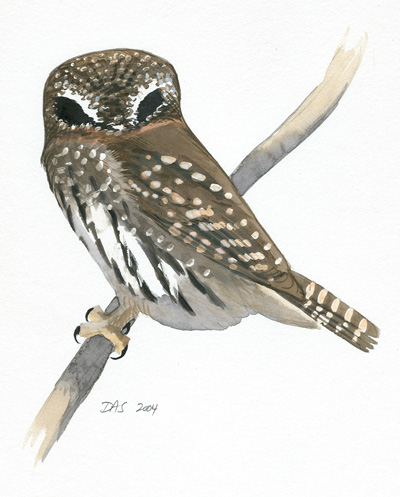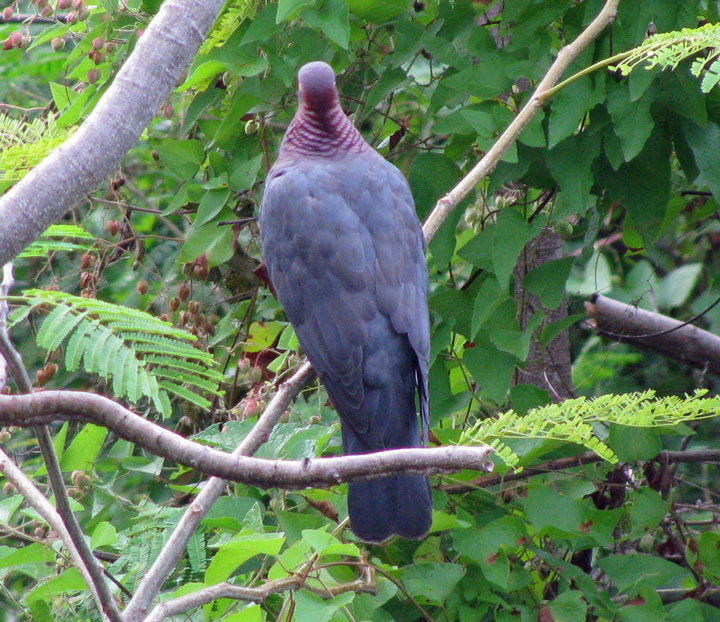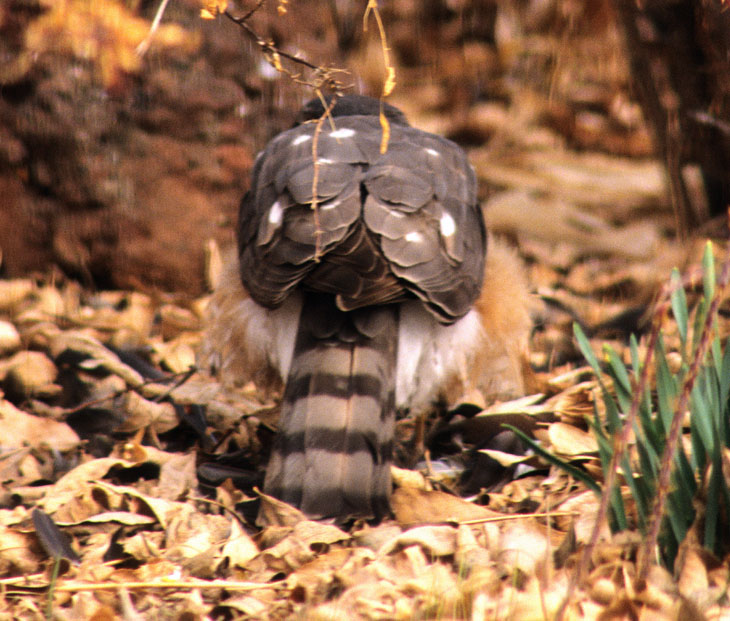In a previous post I wrote about false faces in birds, using the example of a Downy Woodpecker to show how color patterns create the illusion that the bird is looking straight at you when, in fact, it is looking the other way. I promised a few more examples, so here they are:
First, one of the classic examples, here is a painting I did of a Northern Pygmy-Owl showing the pattern of “false eyespots” on the back of the head. Other species of pygmy-owls have the same pattern. Northern Hawk-Owl also has a bold pattern on the back of the head that creates the illusion of a face.

At Saint John, USVI in December 2009, I spent some time watching the local Scaly-naped Pigeons (Patigoenas squamosa) feeding in the treetops, and I was often momentarily confused about which way the bird was facing. The very simple pattern on the crown and nape was surprisingly effective at creating the illusion of a face.

Finally, thanks to Chuck Carlson, here is a photo of a Sharp-shinned Hawk mantling prey on the ground. The white spots on the wing coverts, together with the dark shadow between the wings, can be seen as a face. You may not be convinced by this photo, but I have been convinced by several experiences in the field during which I was struck by the very strong impression of a face on the back of Sharp-shinned Hawks in this position. Presumably Cooper’s Hawk is the same. Cooper’s Hawk also has a subtle false face illusion on the back of the head, as do many other hawks.

As evidence of the effectiveness of these false faces, and the ability of species to see faces of very distantly related species, I will point to one example: Researchers who venture into gull and tern colonies are subject to dive-bombing attacks from the birds, and sometimes wear masks (of human faces) on the backs of their heads to fool the birds. These false faces are apparently very effective at preventing attacks.


So gulls/terns are confused by the Janus-faced, eh? Me, too.
I just photographed a Cassin’s Finch on my back patio today and having read your recent blog entries I wasn’t surprised that it too had a false face on the back of its head.
Thanks for both of these “false face” posts, David. It must work often enough for it to be genetically selected with such apparent commonality. Do other animals’ brains find patterns like faces in abstract shapes as the human brain does in a Rorschach test?
Hi Nathan, Good question. Personally I have no doubt that animals perceive these patterns as faces, but I don’t know if that’s ever been tested specifically. And it would be interesting to know how far that perception goes; for example, would birds recognize the iconic “smiley face” symbol as a face?
One of my Flickr contacts pointed to this and the other “faces” posts. Neat! I had not idea about this – thinking I was likely just letting my imagination run away! I saw something like that in a northern harrier (http://www.flickr.com/photos/vitrain/4221154222/).
I admit that I can see the hints of a face in your photo. It’s an unusual posture for a harrier, they wouldn’t normally be like this except for a split-second as the wings move, but some of these elements might come together to create a face when the wings were closed. It seems plausible that this and the subtle face of the Sharp-shinned Hawk in Chuck Carlson’s photo would give these birds an advantage when they are mantling prey. They would be preoccupied with their meal, with their heads down, and very vulnerable to attack from the rear in which they could either lose their meal or possibly lose their life. So I think it’s possible that this is a functional false face, but I wouldn’t go too far with this one photo. More study needed, and more photos of raptors from behind with heads hidden.
Very intriguing subject. I can comment that my experience with the Least Tern is such that it is an extremely aggressive dive bomber in its attempt to protect its breeding grounds. Staying low to the ground is an effective counter measure to harassment from the birds. A recent encounter, my first, with Cooper’s Hawk, did not give any insight of such a phenomenon as a false-face. When I observed the bird with photo gear at the ready, I was shooting into the sun. My immediate goal was to move to the bird’s right and behind for better lighting for photography as it had a Eurasian-collared Dove in its clutches on the ground without thought to capture multiple images along my route. I will think differently in the future. My blog post making reference to the latter species can be seen here . . . http://swfloridabirder.blogspot.com/2010/03/when-you-least-expect-it.html
It wasn’t until after reading this piece on false faces that I paid closer attention to the idea. I have seen thousands of White Crowned Sparrows and photographed hundreds of images of them and I had never noticed a false face on one before taking this image the other day:
http://www.flickr.com/photos/bobmckay/4541149636/
The original post had the wrong link.
I agree with Bob Pelkey, these markings really look like a face. Thanks for sharing the photo Bob! I suspect that many (possibly most or all) species with bold head stripes will show a similar suggestion of a false face on the back of the head. There’s a corollary to this false-face illusion that I’ve been thinking about: at the same time that birds want predators to see a face and think the back of the head is the front, they want predators to think the front of the head is the back. I think the illustrations of kestrels by Clay (1953 – mentioned in my previous post on this) show how the markings produce both of these illusions, and I wonder if the pale bill and lores of some White-crowned Sparrows help to make the front of the head look LESS like a face at the same time the dark stripes make the back of the head MORE like a face.
Your image of the WCS seems extremely convincing for this subject, Bob.